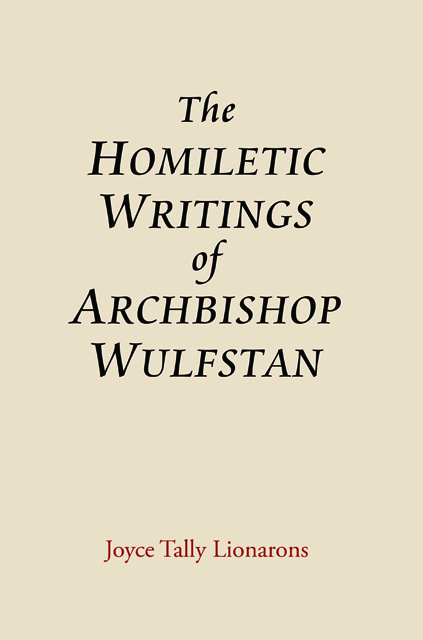Book contents
- Frontmatter
- Contents
- Acknowledgements
- Abbreviations
- Manuscript Sigla
- Introduction
- 1 Wulfstan and Wulfstan Manuscripts
- 2 Re-establishing the Wulfstanian Homiletic Canon
- 3 Wulfstan’s Eschatology
- 4 Salvation History and Christianity
- 5 Wulfstan as Archbishop
- 6 Sacramental Sermons
- 7 The Danish Invasions and the Sermo Lupi ad Anglos
- 8 Homilies Based on Legal Codes and the Institutes of Polity
- Bibliography
- Index
- Miscellaneous Endmatter
1 - Wulfstan and Wulfstan Manuscripts
Published online by Cambridge University Press: 18 February 2023
- Frontmatter
- Contents
- Acknowledgements
- Abbreviations
- Manuscript Sigla
- Introduction
- 1 Wulfstan and Wulfstan Manuscripts
- 2 Re-establishing the Wulfstanian Homiletic Canon
- 3 Wulfstan’s Eschatology
- 4 Salvation History and Christianity
- 5 Wulfstan as Archbishop
- 6 Sacramental Sermons
- 7 The Danish Invasions and the Sermo Lupi ad Anglos
- 8 Homilies Based on Legal Codes and the Institutes of Polity
- Bibliography
- Index
- Miscellaneous Endmatter
Summary
WULFSTAN was consecrated bishop of London in 996; in 1002 he was elevated to bishop of Worcester and archbishop of York, holding the two sees in plurality until his resignation of Worcester in 1016, and continuing as archbishop of York until his death in May 1023. What little we know of his life has been gleaned from relatively few sources: charters dating from 996 through 1023 bear his signature, and he is mentioned by name four times in the Anglo-Saxon Chronicle: at his accession to the bishopric of London (F 996), celebrating the consecration of Cnut's church at Ashingdon (D 1020), consecrating Æthelnoth as archbishop of Canterbury (F 1020), and at his death (E 1023). In addition, he almost certainly performed the consecration of Ælfwig as bishop of London, reported in D 1014, since the ceremony was performed at York. The twelfth-century Liber Eliensis lists him as a patron and benefactor; he was also a benefactor of Peterborough, and it is possible that he had been educated at one of the two abbeys. He was buried at Ely in 1023, apparently to the dismay of Peterborough, and at the completion of Ely cathedral in c.1054 his remains, along with those of six other benefactors, were translated from the abbey chapel to the north wall of the cathedral choir. A second translation in 1771 to accommodate the rebuilding of the choir placed the seven where they remain today, in Bishop West's chapel in the southeast corner of the cathedral. Before the north wall was demolished, however, there had been effigies in the form of wall paintings above each of the graves, and two eighteenth-century reproductions of Wulfstan's painting survive, each depicting the seated archbishop with mitre and staff: the first, a pen-and-ink drawing by William Stuckey dated c.1735–41, the second a watercolor made by Michael Tyson in 1789. A single artifact in the form of a bronze pin with traces of silver found in the archbishop's grave also survives; it was apparently one of several gilt spinulae used to attach the pall to his chasuble at his burial.
The Liber Eliensis also makes it clear that Ely attempted to profit from the burial by creating a Wulfstan cult, claiming that miracles were frequently reported at his grave (sepe contingebant miracula).
- Type
- Chapter
- Information
- The Homiletic Writings of Archbishop WulfstanA Critical Study, pp. 9 - 22Publisher: Boydell & BrewerPrint publication year: 2010



